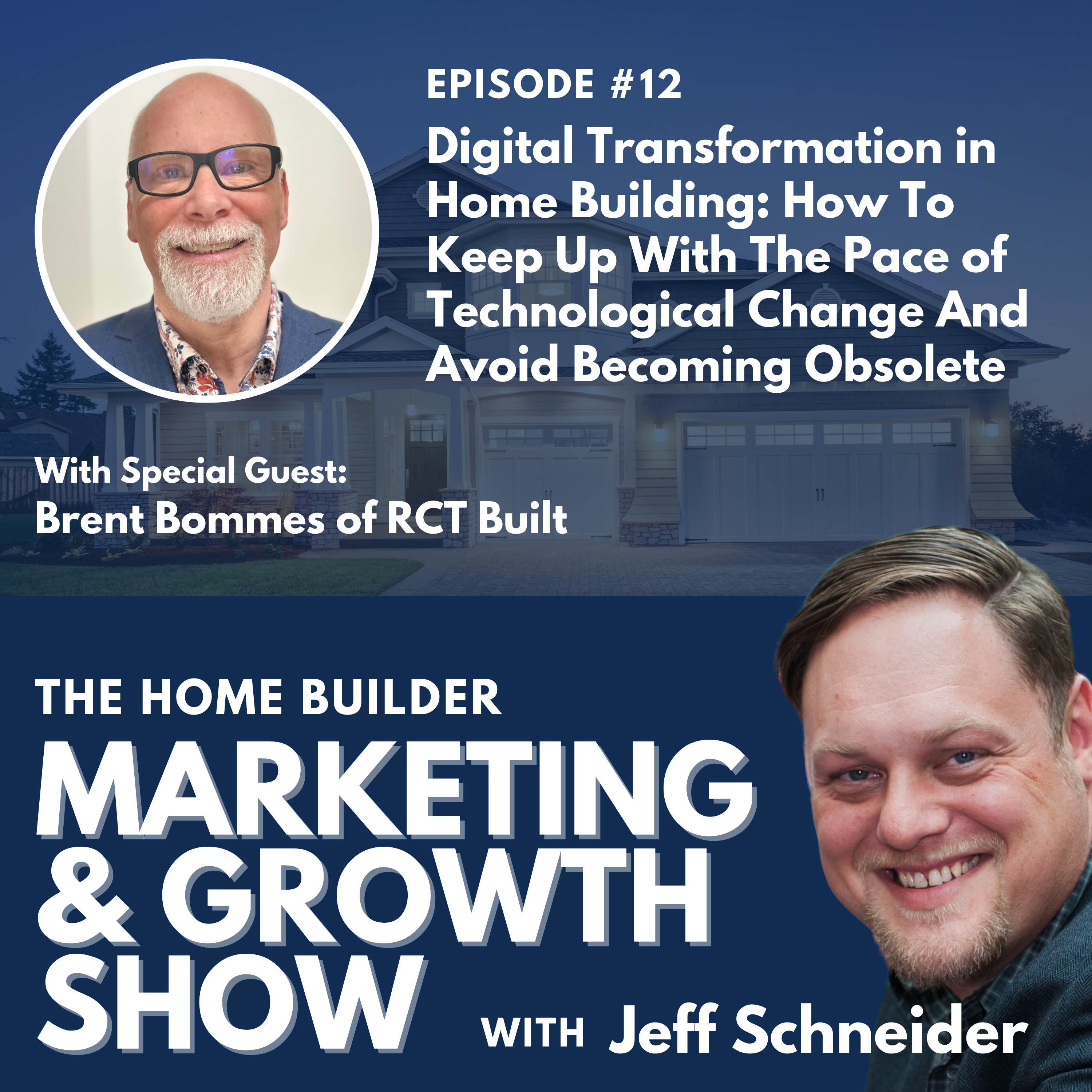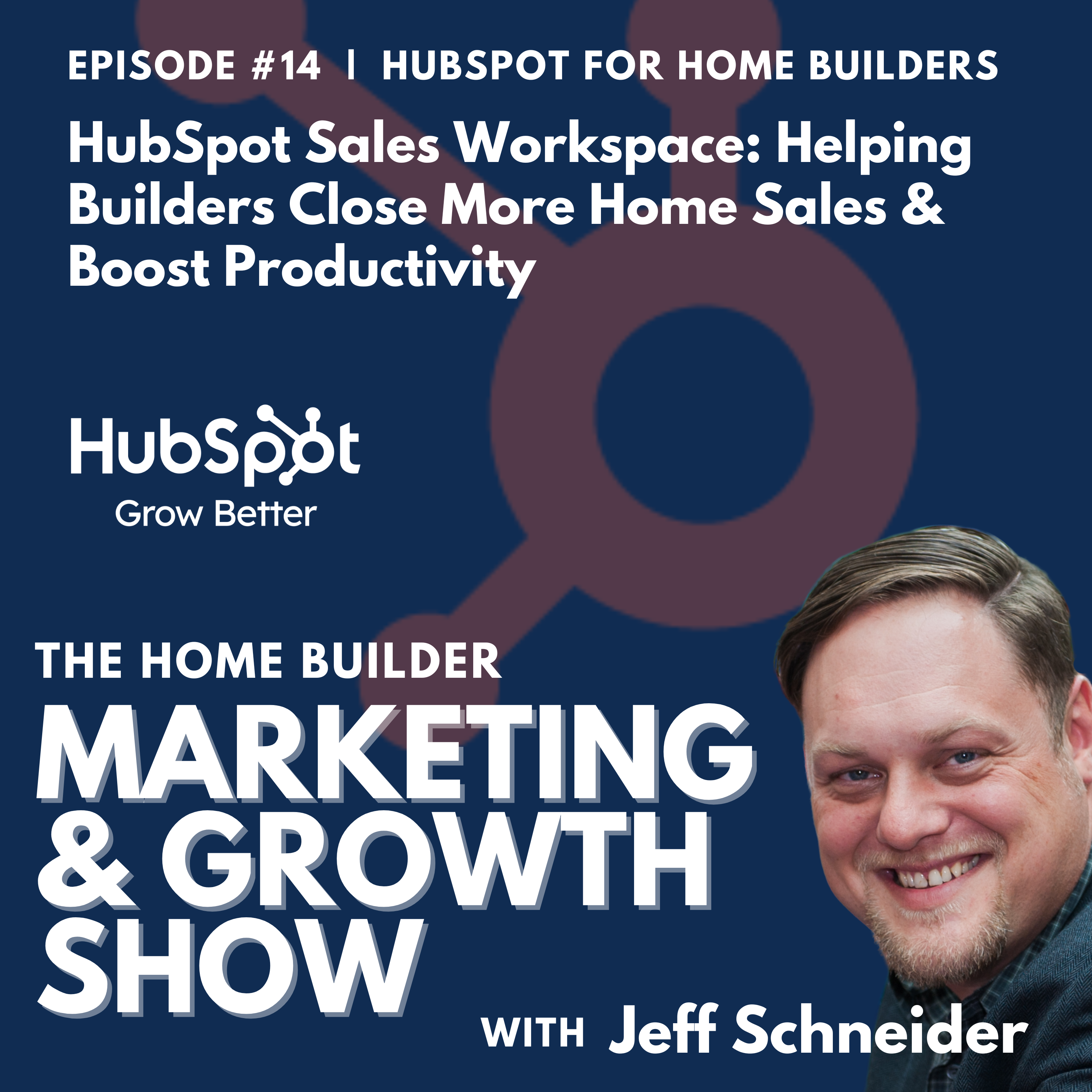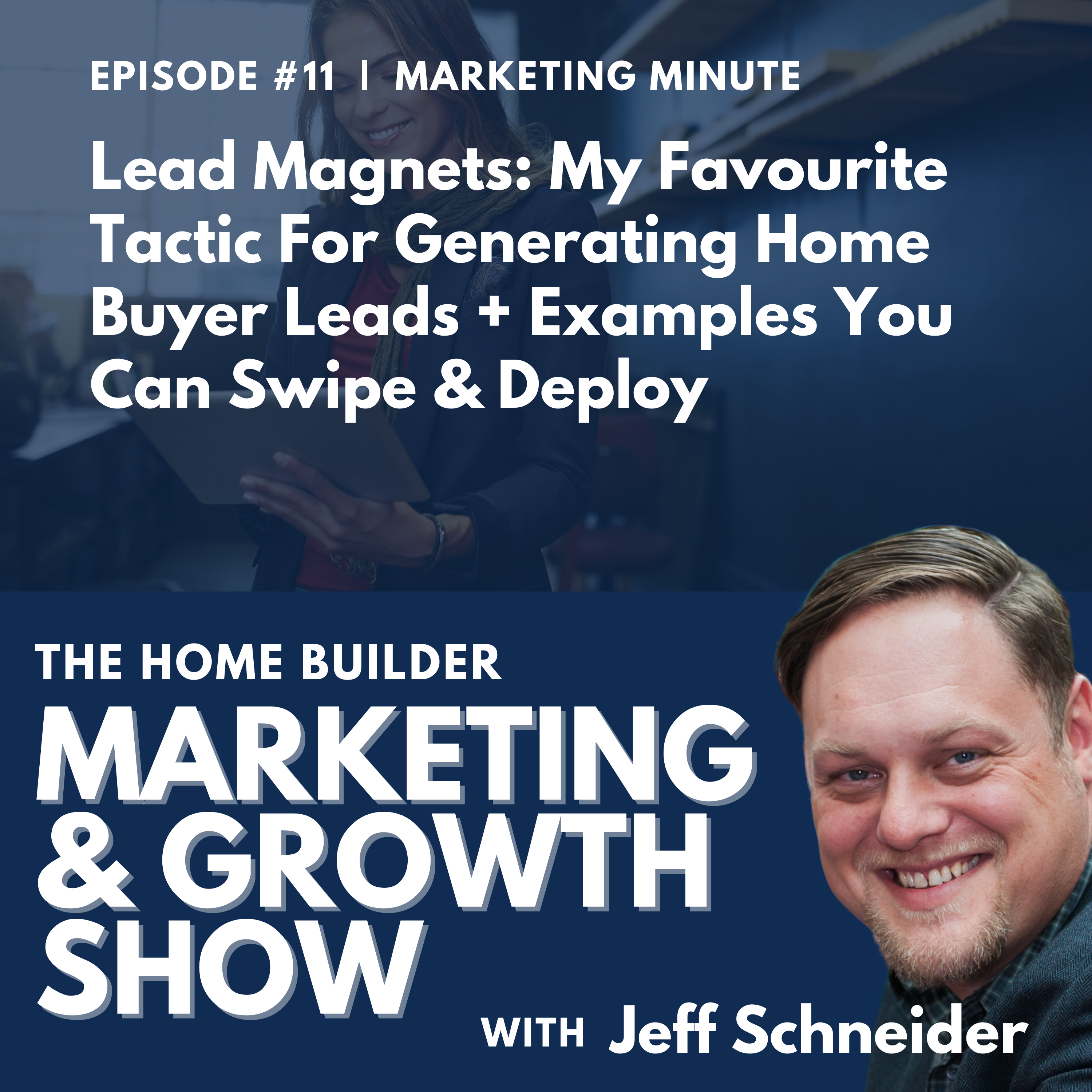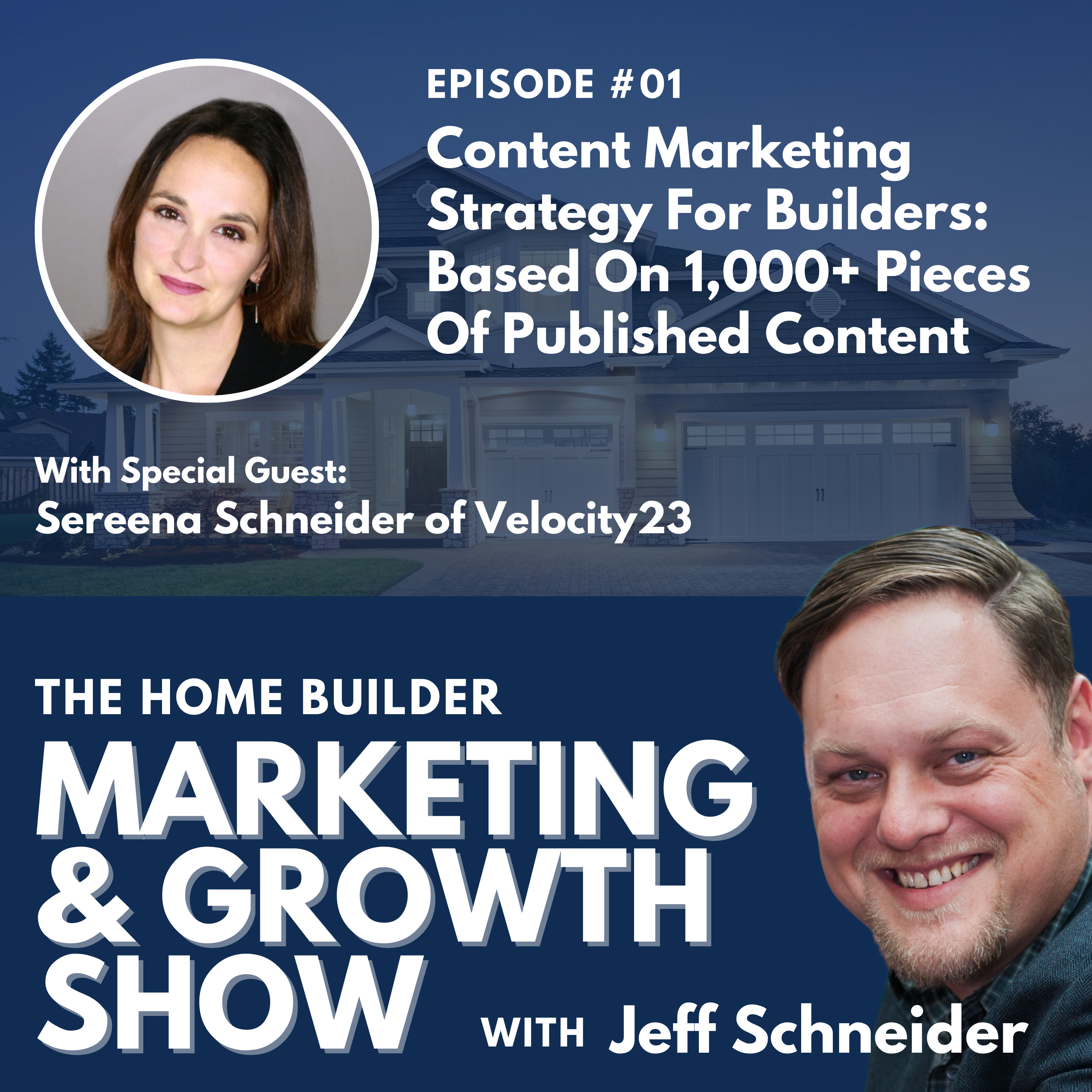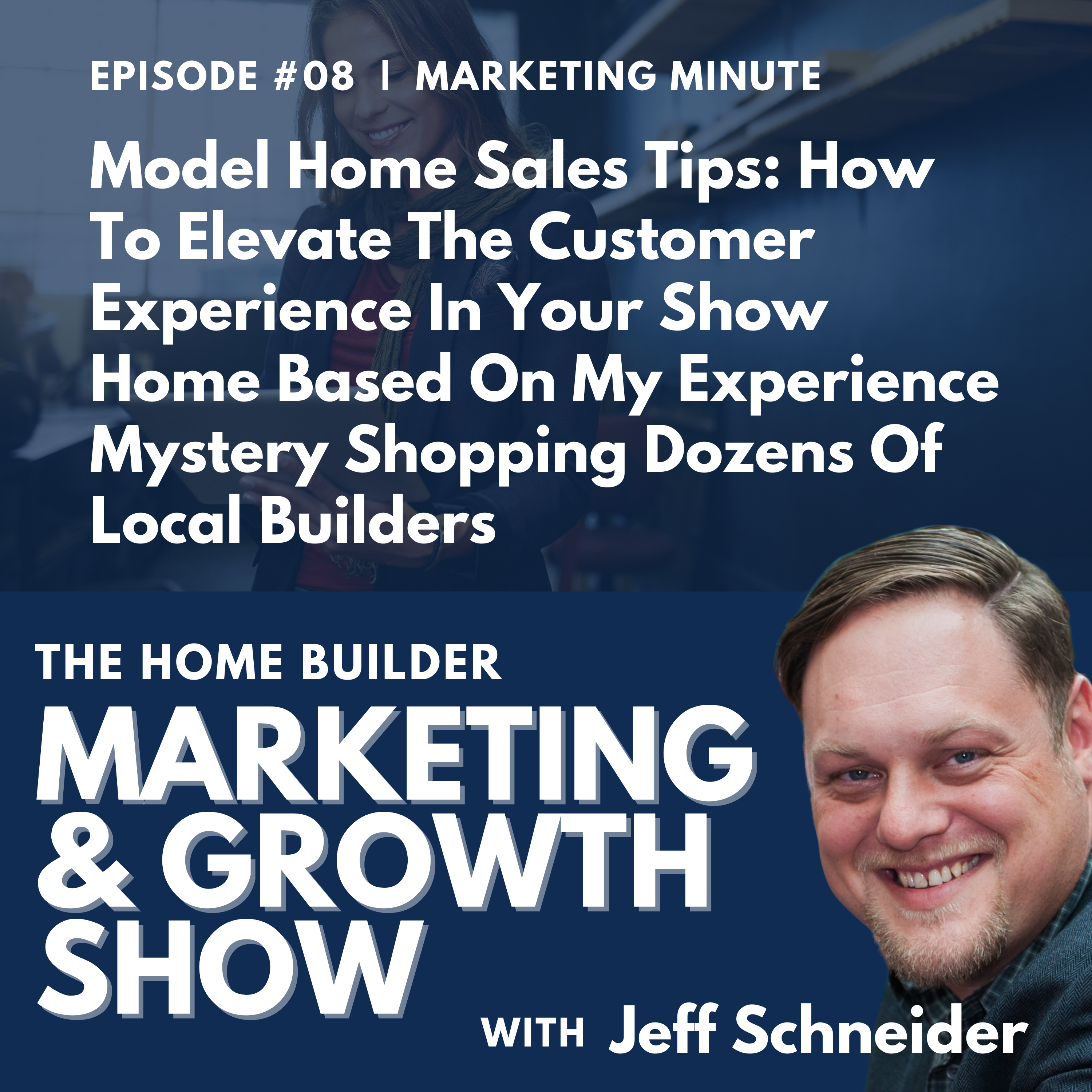Episode Transcript
[00:00:00] Did you know that homebuyers spend months researching before they ever talk to a sales rep? Yet most builders only focus their marketing on the 3% that are ready to buy today. Well, what about the other 97%? In this episode of the Homebuilder Marketing and Growth Show, I'm sharing my favorite blogging strategy that helps capture the attention of future buyers by becoming their trusted guide through the home buying journey. Now, this approach has helped our clients to generate over 7.4 million website sessions, over 110,000 leads, sell more than 9,600 homes, and generate more than $3.4 billion in revenue, all by answering the questions that homebuyers are actually asking long before they're ready to build. So by the end of this episode, you'll understand exactly how to implement this strategy in your business as well. I'm your host, Jeff Schneider with Velocity 23, and welcome to the show. Today, I want to talk about something that I see all the time with home builders. They put up a beautiful website with gorgeous photos of their homes. They list all their communities and floor plans, and then they sit back and they wait for the leads to come rolling in. But here's the thing. It doesn't work that way anymore. We've always sort of had this build it and they will come mentality to marketing homes. But times have changed and people don't buy that way anymore. Think about it. When was the last time that you made a major purchase without doing any research first? Today's home buyers spend anywhere from a few months to a year or longer doing their research before they even reach out to a sales rep. And during that time, they're forming opinions about which builders they trust based on the information that they find online.
[00:01:40] I believe that this is where most builders are missing a huge opportunity. So I talked about the larger market formula in episode number two. This is fundamental to homebuilder marketing. And if you missed that episode, I would go and check it out. Most builders are laser focused on the 3% of people that are ready to buy a new home right now. You know, the ones that are actively shopping and they're coming into the show homes. But what about the other 97%? These are people who know they have a housing problem to solve, but they're still in research mode. So they're trying to figure out things like, is it better to build new or buy resale? What's a good neighborhood for my family? How much home can I afford? This is why blogging is so crucial. It's not Just about creating content. It's about being there with helpful and relevant information when your future customers are doing their research. And the best part is that you probably already have 80% of this content. It's in your sales materials, it's in your team's heads, it's your email responses. You just need to organize it and put it on your website in a way that you can send it to prospects and so that Google can find it. Now, I know what you're thinking, Jeff. We don't have time for blogging. We're too busy doing other things and trying to sell homes. And I hear this all the time. And here's what I tell builders. You're already creating this content every single day between your sales teams, your OSCs, everyone in your company. You're constantly answering the same questions over and over. All we're doing is capturing those answers and presenting them in a way that's going to work for you 247 to help you attract and nurture more leads so that your sales team can focus on closing deals. So think of your blog as your hardest working sales assistant. It's one that never takes vacation and it answers questions around the clock. Let me show you something fascinating. I want you to pull up your website analytics right now. Go and look at what your most visited web pages are. They're probably your floor plans and your community pages right now. Think about all the questions that people ask about those floor plans and communities. Each of those questions represents dozens, maybe even hundreds of potential buyers that are searching for answers every month. And when you're the builder that's providing those answers, you build trust and rapport with those prospects. So each one of those questions represents a blog article that you can write that has the power to educate and influence the buying decision. That's how we've helped builders generate more than 7.4 million website visits using this approach. Another question that I get a lot is always about time and resources. How long is this going to take? Or when are we going to see results? So the reality is, is that blogging is a long term strategy. But I can tell you from working with dozens of builders across North America that when you commit to it and you do it right, the results are incredible. It's not uncommon to see a builder that adopts this strategy to 10x their lead flow. Think about that for a minute. How many more homes could you sell next year if you had 10 times as many leads as you have now? Okay, before I dive into the specific types of blog posts that I Create every month. I want to be clear about one thing. So this isn't about writing novels and it's not about becoming a professional writer. It's more about systematically sharing the knowledge that that you already have in a way that's going to help your future customers to make better buying decisions. And when you do that consistently, you become their go to resource for information about building a new home and you get to be their advisor while they move through that home buying journey. So the first type of blog posts that I write every month are educational blog posts. This is your foundation. About 50 to 60% of your content should fall into this category. And there's a really good reason for that. Remember that larger market formula that I mentioned in episode 2? Well, we know that only 3% of the market are actively shopping for a new home at any given time and another 17% are gathering information. 20% know that they have a housing problem, but they haven't started looking for solutions yet. And 60% they're not even aware they have a housing problem, but they will eventually and they'll end up buying. So educational content helps you to connect with all of these groups of people and here's why that matters. When you're the one that's educating them, you position yourself differently than every other builder in your market. It helps you build a real connection with prospects long before your competitors do. So let me share a real case study about this. We worked with Sterling Homes in Edmonton and like many builders at the time, they were primarily focused on traditional marketing. So primarily radio and billboards and that kind of thing. The challenge at the time though was that the market was beginning to cool and sales throughout the city were declining. And so we convinced them to try something different. We implemented a systematic content strategy that was focused on educating first time home buyers. And the results were incredible. In just the first 12 months, their website traffic grew by 17%, their leads increased by 130%, and most importantly, they sold 118 more homes than they did the previous year. That's what happens when you focus on answering the real questions that your buyers are asking. But Jeff, our market's different. Is it really though? I've been specializing in the new home market for more than 13 years now and have worked with builders all across North America and in many different markets. And I can tell you that while every market is a little bit different, people still buy homes the exact same way. So how do you create educational content that's actually going to work? Well, first you need to map your content to the home buyer's journey. So we spent countless hours in focus groups with recent and soon to be home buyers, and we've identified that there's 19 key questions that they ask during their journey. So these become your blog post topics. So what you want to do is write a thoughtful article that teaches people what they need to know to confidently answer those home buying questions. So here's a powerful framework that I learned from Marcus Sheridan's book. They ask, you answer. And the concept is beautifully simple. Write down every single question that your sales team gets asked and turn each one of them into a blog article. It works because you're creating content that directly answers what your prospects are actually asking, not what you think they want to know. So when we implemented a similar strategy with Sterling Homes, focusing on answering the questions that first time home buyers were asking, their annual website Traffic grew from 148,000 visits to 174,000 visits in just the first 12 months. And we continued this strategy focusing on the other buyer Personas that they sold to. And by the end of their third year, their annual website visits reached over 581,000. That's the power of answering real questions from real buyers.
[00:08:44] Let me give you some examples. At the beginning of the journey, people are asking questions like, is it better to build new or buy resale? Or how much does it really cost to build a new home? And as they move further along, they're asking things like how do I choose the right floor plan? Or what should I look for in a home builder? So the key here is to be genuinely helpful without being salesy. So think of yourself as a trusted advisor. For example, when you write about choosing the right floor plan, don't just talk about your floor plans. Instead, provide actual guidance. Talk about how to evaluate your family's needs, or what to consider for future growth, or how to compare different layouts effectively. Then naturally you can mention how your floor plan addresses these considerations. But here's the thing about educational content. You have to commit to quality. We're not just throwing 500 words on a page to check a box. Our best performing posts are typically 1200-1500 words. And they include things like checklists, comparison guides, or downloadable worksheets. Because here's what happens. Someone finds your blog post through Google, they read it and they find it genuinely helpful. And then they see that they can download a tool to help them utilize what they just learned. So they're much more likely to give you their email address because you you've already provided value and You've built some trust. The beautiful thing about educational content is that it works for you 24 7, 365 days a year. So once it's published and optimized, it continues drawing in prospects and building trust with them, even when your sales office is closed. And when these prospects do finally reach out to sales, they're much more educated, which makes them easier to sell to. And they're often further along in their decision making process, which usually means a shorter sales cycle.
[00:10:35] The second type of blog post that I publish every month is local SEO content or search engine optimized content. So this should make up about 20 to 30% of your content strategy. And it's absolutely crucial for visibility in your market. So when it comes to local SEO content, you're really creating two things at once. Helpful local information for your prospects and strategic content that Google loved to rank. And while educational content is pretty straightforward to write because you're just sharing what you know, SEO focused content requires more research and more strategy. So when you get it right, the results are incredible because you're attracting visitors to your website who are actively searching for information about where they want to live. Let me show you what I mean. We wrote an article for Copper Builders about the Noda neighborhood in Charlotte. Now, this wasn't just a basic overview. We studied what was already ranking, we analyzed the content structure, and we created something that was more comprehensive than anything else that was already out there. And the results were that that single article now ranks number four for their main keyword, but it also shows up for 218 other organic keywords. It now brings in over 1100 qualified visitors every single month who are actively researching life in Noda. So just from that one blog article, that's the power of strategic SEO content.
[00:12:03] Here's another example of the power of local SEO focused content. So Alberta, Canada is seeing a massive influx of people that are moving into the province. So we wrote an article for our client comparing Edmonton to Calgary, the two major cities in the province, to help people decide which city would be the best fit for them. By following this SEO strategy, doing deep keyword research, creating comprehensive coverage, and properly optimizing that blog post, it hit number one for its target keyword. Today, that single article ranks for 381 different keywords, and it brings in over 1750 organic visitors to the website every month. So these aren't just random visitors. These are people that are actively researching what where they want to live. And when they make their move, they're going to need a new house. To live in SEO or search engine optimization sounds complicated and there are a lot of components to it. But let me give you some direction on how to create local, focused blog articles that rank. First, you need to know what keyword phrase people are searching for. So use tools like Semrush or Ahrefs to find what people are actually searching for. Then you want to search for that term in an incognito window and study what's already ranking. Look at the content structure, what topics do they cover, what H2 and H3 headers do they use. The other thing you want to pay special attention to is the People Also Ask section in the Google Search results because these are gold for coming up with content for your Frequently Asked Questions section on your page. Then you want to create an article that's more comprehensive than what's currently out there. Use those same header structures, but go deeper with your local expertise. And don't forget your images. They need to have SEO friendly file names and alt text as well. Another tool in my marketer's tool belt is a software called Surfer SEO. It's incredibly valuable for analyzing existing content and it helps me to understand exactly what I need to include in my content for it to rank well. So this isn't about keyword stuffing. It's about creating genuinely helpful content that's strategically created to match what Google is already ranking. So it's like reverse engineering the winning formula. It's very powerful. But think about what this could mean for your business. We just talked about two blog posts. One bringing in over 1100 visitors a month, another bringing in over 1750. Now imagine having 10 or 20 pieces of content like that on your website. That's thousands of qualified prospects that are finding you every month through organic search, all because you took the time to create strategic, SEO focused content about your market. So the key is to be comprehensive. Here again, we're not just writing 500 words about how great a neighborhood is. You have to dig deep. So talk to your sales team. What questions do people always ask about each area? What concerns do people have? What usually surprises them? Look at competing content and identify what's missing. Then create something that's better, more detailed and more helpful than anything else that's out there. And here's a pro tip. Encourage your sales team to use these articles as resources. So when prospects ask about different areas, your sales team can ask the prospect for their contact info and then send them these detailed articles. So you capture the prospect's contact info in an ethical way and you set the expectation that you will be following up with them. And you help the prospect by giving them information that helps them do their research. And it also signals to Google that people are finding the content valuable. So everyone wins. Now, the third type of blog article that I publish every month are promotional blog posts. So this is an area where a lot of builders get it wrong though. They either do way too much promotion or they're afraid to promote at all. Now I going to show you how to strike the perfect balance. So here's the golden rule when it comes to promotional content. Stick to the 8020 rule. That means that 80% of your content should be educational or SEO focused and only 20% should be promotional. Why? Because if everything that you publish has come by from us, people will tune out. But when you've already established yourself as a helpful resource through your educational content, your promotional posts actually work better. Because your audience is more receptive, because you've earned their trust. Here's a perfect example of how this plays out. So one of our clients was launching a new product line, a brand new series of starter home models in a very popular area. And instead of just simply announcing it, we created a series of three educational posts. First one about homeownership benefits, the second one about the affordability of new homes for first time buyers, and then the third about the neighborhood itself. And we promoted these posts to our target audience and we built an interest list. So by the time we published the promotional post announcing the new townhomes, we had a hot list of qualified prospects who already understood the value. And the result of that was that they completely sold out phase one with 14 deposits in the first 24 hours of launch. So you might be thinking, jeff, that's great, but we need sales now. And I get that. Let me ask you a few questions. Were you in the same position last year or six months ago? Three months ago? Are you going to be in this same position again six months from now or a year from now? Look, implementing a content strategy is like buying a home. And we've all heard the advice. The best time to do it was a year ago. The second best time to do it is right now, today. And although it's more of a long game, it is a game changer. So it might not have a drastic impact on your sales in the next 30 days. But fast forward three, six, even nine months from now, and it absolutely will if you do it right. So here's how to make promotional content work harder for you. First, think about your promotional posts as part of a sequence, not just one off Announcements so let's say you're planning to launch a new show home. Well, instead of just posting new show home opening soon, create a series. Start with a post about the neighborhood, then one about the unique features of this new model, Then a behind the scenes look at the construction progress. Now when you make your promotional announcement, you've built some anticipation and you've educated your audience about why they should care. But the key is to make your promotional posts valuable even when you're selling. And here's what I mean. Instead of just announcing your spring promotion, write a post that helps people to understand how to evaluate builder promotions. Break down the different types of incentives that are common. Explain what adds the most value for the buyer, then naturally transition into how your current promotion aligns with that value. Now you're not just promoting, you're educating while promoting, which builds trust and it positions you as transparent and helpful. So here's a proven promotional strategy for quick possession or quick move in homes. Start with a blog post about when quick possession makes sense and cover the scenarios like job relocation, lease endings, and moving during summer break. Then promote that post to your target audience with an email signup to get updates about your available quick possession homes. So now when you announce new inventory, you're talking to a list of people who already are legitimately interested and they understand the value. Things like no time waiting for construction or fewer design decisions to make, and moving dates that align with their timeline. We consistently see higher conversion rates with this approach because buyers come in already understanding why quick possession might be their best option. Now I want to make a comment about timing these promotional posts. The best time to promote is when you've earned the right to promote. And that means that you've already provided value through educational and SEO content. So think of this like making deposits in a trust bank. Each helpful post is a deposit and promotional posts are withdrawals. And as long as you stay in a positive balance by providing more value than you ask for, your promotional content will be really well received. And here's a pro tip about calls to action in your promotional posts. Always give people multiple ways to engage. Some might be ready to talk to sales, but others might just want more information. So on every promotional post I like to include three CTAs. One high commitment option like book a consultation, one medium commitment like download our buyer's guide, and then one low commitment like subscribe to our updates. This way you're capturing leads at every stage of readiness, not just the ones who are ready to Buy today. The last thing that I want to share about promotional posts is how to measure their success.
[00:20:58] So don't just track direct conversions. You have to look at the promotional content halo effect. So when you do promotion right, you'll see increased engagement on your educational posts. You'll get more downloads of your lead magnets, and you'll get higher conversion rates on your sales calls because people are coming in more educated about your value proposition. So that's how you know that your promotional strategy is really working. Remember that the goal of promotional content isn't just to sell. It's to give people the information that they need to confidently choose you as their builder. So when you approach it this way, your promotional posts become a natural extension of your educational content, not an interruption. So remember, blogging isn't just about creating content. It's about building trust with prospects throughout their home buying journey. And when you consistently publish the right mix of SEO, educational and promotional content, you create a sustainable system for attracting and nurturing leads long before they're ready to buy from you. So to help you implement everything that we've covered today, I've put together the homebuilder Blogging Cheat Sheet. And it gives you everything that you need in order to publish effective blog posts. To help scale up your website traffic, just visit the link that is in the Show Notes and you can download your copy there. And if you found this episode valuable, please subscribe to the Home Builder, Marketing and Growth show and share it with a colleague who could benefit from better blogging strategies. You can also connect with me on LinkedIn. Just search for Jeff Schneider or you'll find a link to my profile in the Show Notes as well. And I want to thank you, the listener, for tuning in today. And remember, every blog post is an opportunity to earn trust with your future customers. Make sure you're giving them the information that they need to choose you as their next builder. Thank you so much and we'll see you next time.

